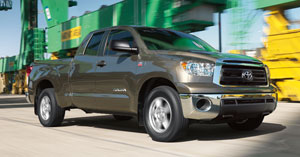 Barring some new calamity, the three biggest corporate villains of 2010 have been Goldman Sachs (GS), BP plc (BP) and Toyota Motor (TM). All have been subjected to Congressional inquisitions and seemingly endless pillorying by the media, and all have parted with significant sums of money in an effort to put their problems behind them. At least one appears to have been the victim of a rush to judgment.
Barring some new calamity, the three biggest corporate villains of 2010 have been Goldman Sachs (GS), BP plc (BP) and Toyota Motor (TM). All have been subjected to Congressional inquisitions and seemingly endless pillorying by the media, and all have parted with significant sums of money in an effort to put their problems behind them. At least one appears to have been the victim of a rush to judgment.
The WSJ has a report out that Toyota’s vehicles that supposedly ran amok were in fact most likely misused by those in control of the cars.
Five months into an investigation of safety issues involving Toyota Motor Corp. vehicles, U.S. safety officials have yet to identify any new defects beyond those reported by the car maker itself.
And in more than half of the crashes blamed on sudden acceleration analyzed by the government, data from the vehicles’ “black boxes” show the driver was not stepping on the brake at the time of the accident—indicating that driver error may have been at fault.
This is hardly news. Holman Jenkins, for one, pointed out that the sad history of “sudden acceleration” incidents argued that driver error was probably going to be the end finding:
No such inhibitions trouble the National Transportation Safety Board (the folks who investigate plane crashes). Last fall, they issued a special report on four school-bus accidents and a fire-truck crash, fingering “pedal misapplication” in every case: “In all five, the drivers either reported a loss of braking or were observed by vehicle occupants to be unsuccessfully attempting to stop the vehicles, though no evidence of braking system failure was found.” And these were professional drivers!
I wonder how many congressmen were around for the industry-wide crisis kicked off years ago by Audi. In 1987, the feds received 2,500 complaints of “unintended acceleration,” more than in the previous 20 years combined. “The defect, which involves almost all makes of cars, causes them to accelerate without warning. . . . Sophisticated electronic controls are now believed to play a role in the problem,” concluded the New York Times, citing (who else?) Clarence Ditlow, the trial lawyer handmaiden who will be testifying against me today.
Two years later, the National Highway Traffic Safety Administration issued its own exhaustive report on the post-Audi fury: “pedal misapplication.”
So Toyota suffers a devastating hit to its reputation, spends a king’s ransom fixing a non-existent problem and still stands exposed to millions of dollars of damages stemming from lawsuits claiming faulty engineering for a problem that never existed. Most, if not all, in furtherance of the creation out of thin air of liability claims amenable to lining the pockets of the tort bar.
One would think that the findings so far would induce at least a bit of embarrassment on the part of some of those who played a part in the demonizing of Toyota. One would be mistaken.
Rep. Bart Stupak (D., Mich.), chairman of the Energy and Commerce Committee’s oversight panel, which held hearings on the Toyota recalls this year, said the report resolved few questions about the sources of the Toyota crashes.
Never admit error, particularly when your lawyer donor base might have cases pending.
- Bulenox: Get 45% to 91% OFF ... Use Discount Code: UNO
- Risk Our Money Not Yours | Get 50% to 90% OFF ... Use Discount Code: MMBVBKSM
Disclaimer: This page contains affiliate links. If you choose to make a purchase after clicking a link, we may receive a commission at no additional cost to you. Thank you for your support!


This fiasco just portrays how low this country's political and judicial system has become. Can the US government be sued by Toyota for intentionally harassing a company that is the direct rival of which the US government is a majority stakeholder?
So if Toyota cars are safer than ever before, what are we to think of all these people running to buy Fords? Trashing your rival never improves the quality of what you are making, right?